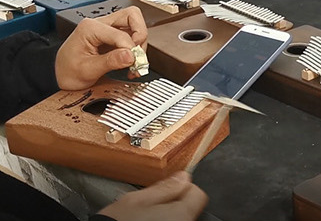Kalimba is a popular musical instrument with a distinct sound. It’s easy to learn, but there are some common errors that can make it difficult to get the desired sound. Let’s explore some of these common mistakes and learn how to avoid them so you can make great music with your kalimba.
Tuning Issues
One of the most common mistakes made by new kalimba players is not properly tuning the instrument. A poorly tuned kalimba will sound out of tune and create an unpleasant listening experience for both the player and anyone else in earshot. Fortunately, this issue is easy to solve–simply use a tuner to get your kalimba in tune before playing. Additionally, always check your tuning before playing as even slight changes in temperature or humidity can cause your instrument to go out of tune.
Playing Too Hard
It’s easy to want to bang away on the tines with all your might when playing kalimba, but this often results in an overly loud and harsh sounding tone that isn’t pleasant to listen to. To produce a softer, more nuanced sound, aim for gentle touches when plucking the tines rather than aggressive strumming or hammering. This will take some practice and patience, but once you get the hang of it you’ll be able to produce stunningly beautiful melodies with ease!
Poor Sound Quality
Another mistake that many rookie kalimba players make is neglecting proper care and maintenance of their instrument. Kalimbas need regular cleaning and oiling if they are going to perform at their best–otherwise dust, dirt and grime will accumulate on the tines and dampen their sound quality significantly. Cleaning your kalimba after each use is key if you want it sounding its best every time you pick it up!
Finger Placement Is Key
One of the most common mistakes beginners make when playing the kalimba is not paying attention to finger placement. Each note requires precise finger placement in order for it to sound correctly, otherwise it will sound off-key or muffled. Make sure your fingers are placed directly over each note and lightly press down. This will give you better control over the notes and ensure they sound clear and vibrant.
Not Practicing Enough
Another mistake beginners often make when learning how to play the kalimba is not practicing enough. Learning any instrument takes time and dedication, and mastering the kalimba is no different. As with any skill, practice makes perfect! Set aside time each day to practice playing your favorite songs on the kalimba so you can build up your skills and become a master of this unique instrument.
Poor Posture Finally
Having poor posture when playing the kalimba can lead to bad habits and mistakes in technique over time. Make sure that you sit comfortably with good posture when playing; this will help ensure accuracy and speed while also helping to prevent injury from repetitive motions like plucking strings quickly or pressing too heavily against them with your thumbs.. Additionally, be sure to keep both hands relaxed and loose so that they can move freely across the strings as needed for specific techniques or songs being played.
Conclusion
The Kalimba is a beautiful instrument which requires skill, patience, and dedication in order to master it correctly; don’t let yourself get frustrated! Keep these common mistakes in mind as you practice so that you can avoid them from the start! With some focused effort and consistent practice sessions, soon enough you’ll be mastering all those classic Kalimba tunes! Good luck!
